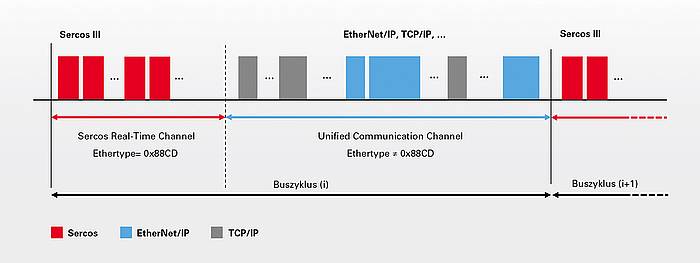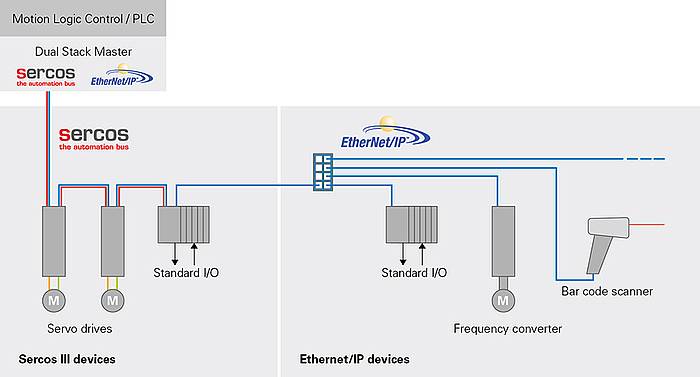Common network infrastructure
 |
The diversification in the automation technology has made machine integration a complex and cost-intensive task. In fact, manufacturers are increasingly using industrial Ethernet solutions. But even if the technical advantages are evident, functioning systems on the basis of traditional field buses are not automatically rendered obsolete.
In addition, there is a number of concurring communication protocols, which are based on Ethernet, but which cannot co-exist within a network infrastructure without influencing performance and real-time characteristics in a negative manner.
There is one solution for Sercos that enables the operation of EtherNet/IP, TCP/IP and Sercos devices via a single Ethernet cable. Neither additional hardware nor tunneling of the protocols is required for that purpose.
For implementing a mixed Sercos and EtherNet/IP network infrastructure, a Sercos master and an EtherNet/IP scanner are required. These functionalities can also be combined in one single device, a so-called dual stack master. If no redundancy is required, the devices are connected in a line topology. When the last Sercos device identifies a Sercos-unknown device on its second Ethernet port, it only transmits non-Sercos telegrams which are destined for other devices. In the reverse direction, the device transmits incoming telegrams via the first Ethernet port to the dual stack master and uses the UC Channel to this end. Standard Ethernet telegrams which come in during the time reserved for the real-time channel, will be retained and subsequently transmitted.
When the application requires a Sercos ring for redundant data transmission of real-time data and therefore no free Sercos port is available, an IP switch must be integrated into the ring or into a device. Its function is to connect and disconnect the EtherNet/IP packets into the Sercos ring. The EtherNet/IP devices can be arranged in different topology types: star and line topologies as well as DLR (Device Level Ring).
The highly efficient Sercos telegrams ensure that only a part of the existing bandwidth is used for the real-data exchange. Sercos needs for an application with 64 drives only 400 microseconds and a 2 milliseconds cycle for example. This means that 1.6 milliseconds are available for the transmission of TCP/IP and EtherNet/IP telegrams.
Since the UC Channel sits directly on the Ethernet layer, TCP/IP and EtherNet/IP as well as other Ethernet users can be connected to the network without any additional hardware. Tunneling of the protocols is not required. Even before a Sercos III communication is initiated by the master, the network users can exchange data via TCP/IP, EtherNet/IP and the S/IP protocol specified by Sercos.The common infrastructure complements the Sercos solution portfolio as, alongside the extensive Sercos product range, EtherNet/IP devices of various manufacturers can be implemented additionally. With this concept, the number of communication interfaces and therefore the hardware complexity will be significantly reduced in machines and facilities. The continuous networking increases the operating efficiency in engineering and in the operation of the facilities.
 |